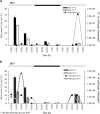The cyanobacterium Mastigocladus fulfills the nitrogen demand of a terrestrial hot spring microbial mat
- PMID: 26230049
- PMCID: PMC4579480
- DOI: 10.1038/ismej.2015.63
The cyanobacterium Mastigocladus fulfills the nitrogen demand of a terrestrial hot spring microbial mat
Abstract
Cyanobacteria from Subsection V (Stigonematales) are important components of microbial mats in non-acidic terrestrial hot springs. Despite their diazotrophic nature (N2 fixers), their impact on the nitrogen cycle in such extreme ecosystems remains unknown. Here, we surveyed the identity and activity of diazotrophic cyanobacteria in the neutral hot spring of Porcelana (Northern Patagonia, Chile) during 2009 and 2011-2013. We used 16S rRNA and the nifH gene to analyze the distribution and diversity of diazotrophic cyanobacteria. Our results demonstrate the dominance of the heterocystous genus Mastigocladus (Stigonematales) along the entire temperature gradient of the hot spring (69-38 °C). In situ nitrogenase activity (acetylene reduction), nitrogen fixation rates (cellular uptake of (15)N2) and nifH transcription levels in the microbial mats showed that nitrogen fixation and nifH mRNA expression were light-dependent. Nitrogen fixation activities were detected at temperatures ranging from 58 °C to 46 °C, with maximum daily rates of 600 nmol C2H4 cm(-2) per day and 94.1 nmol N cm(-2) per day. These activity patterns strongly suggest a heterocystous cyanobacterial origin and reveal a correlation between nitrogenase activity and nifH gene expression during diurnal cycles in thermal microbial mats. N and C fixation in the mats contributed ~3 g N m(-2) per year and 27 g C m(-2) per year, suggesting that these vital demands are fully met by the diazotrophic and photoautotrophic capacities of the cyanobacteria in the Porcelana hot spring.
Figures





References
-
- Bauer K, Díez B, Lugomela C, Seppelä S, Borg AJ, Bergman B. (2008). Variability in benthic diazotrophy and cyanobacterial diversity in a tropical intertidal lagoon. FEMS Microbiol Ecol 63: 205–221. - PubMed
-
- Bergman B, Gallon JR, Rai AN, Stal LJ. (1997). N2 Fixation by non-heterocystous cyanobacteria. FEMS Microbiol Rev 19: 139–185.
-
- Bruland KW, Coale KH. (1985). Analysis of seawater for dissolved cadmium, copper, and lead: an intercomparison of voltammetric and atomic adsorption methods. Mar Chem 17: 285–300.
-
- Capone DG. (1993). Determination of nitrogenase activity in aquatic samples using the acetylene reduction procedure. In: Kemp PF, Sherr BF, Sherr EB, Cole JJ (eds), Handbook of Methods in Aquatic Microbial Ecology. Lewis Publishers: Boca Raton, FL, pp 621–631.
Publication types
MeSH terms
Substances
LinkOut - more resources
Full Text Sources
Other Literature Sources
Miscellaneous

